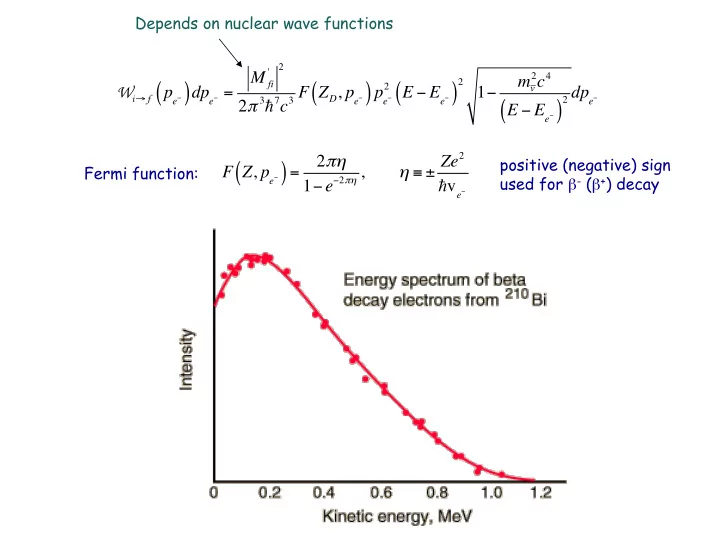

Depends on nuclear wave functions 2 ' M fi 2 1 − 2 c 4 m v 2 E − E e − ( ) dp e − = ( ) p e − ( ) W i → f p e − 2 π 3 ! 7 c 3 F Z D , p e − 2 dp e − ( ) E − E e − η ≡ ± Ze 2 positive (negative) sign 2 πη Fermi function: ( ) = F Z , p e − 1 − e − 2 πη , used for β - ( β + ) decay ! v e −
Dear radioac:ve ladies and gentlemen, As the bearer of these lines [...] will explain more exactly, considering the 'false' sta:s:cs of N‐14 and Li‐6 nuclei, as well as the con:nuous β‐spectrum, I have hit upon a desperate remedy to save the "exchange theorem" of sta:s:cs and the energy theorem. Namely [there is] the possibility that there could exist in the nuclei electrically neutral par:cles that I wish to call neutrons, which have spin 1/2 and obey the exclusion principle, and addi:onally differ from light quanta in that they do not travel with the velocity of light: The mass of the neutron must be of the same order of magnitude as the electron mass and, in any case, not larger than 0.01 proton mass. The con:nuous β‐spectrum would then become understandable by the assump:on that in β decay a neutron is emiUed together with the electron, in such a way that the sum of the energies of neutron and electron is constant. […] But I don't feel secure enough to publish anything about this idea, so I first turn confidently to you, dear radioac:ves, with a ques:on as to the situa:on concerning experimental proof of such a neutron, if it has something like about 10 :mes the penetra:ng capacity of a γ ray. I admit that my remedy may appear to have a small a priori probability because neutrons, if they exist, would probably have long ago been seen. However, only those who wager can win, and the seriousness of the situa:on of the con:nuous β‐spectrum can be made clear by the saying of my honored predecessor in office, Mr. Debye, [...] "One does best not to think about that at all, like the new taxes." [...] Therefore one should seriously discuss every way of rescue. Thus, dear radioac:ve people, scru:nize and judge. ‐ Unfortunately, I cannot personally appear in Tübingen since I am indispensable here in Zürich because of a ball on the night from December 6 to 7. With many gree:ngs to you, also to Mr. Back, your devoted servant, W. Pauli
Beta decay: nuclear matrix elements V int ≈ g δ ! n − ! ) δ ! n − ! ) δ ! n − ! ( ) ˆ ( ( zero-range r r p r r r r O ( n → p ) e − υ The nuclear operator transforming a neutron into a proton must be one body in nature. Hence it must involve the isospin raising or lowering operators. In the non‐rela:vis:c limit, the vector part may be represented by the unity operator :mes τ ± and the axial‐vector part by a product of τ ± and σ . (A proper deriva:on requires manipula:on with Dirac 4‐component func:ons and γ matrices!) σ ( j ) ⋅ ! ! A ∑ [ ] V int → G V τ ± ( j ) + g A τ ( j ) j = 1 Gamow-Teller decay, carries Fermi decay, carries zero one unit of angular momentum angular momentum G V determined from superallowed Fermi beta decays!
Recommend
More recommend